Dynamics of Water Quality and Deficit Irrigation on Residual Soil Micronutrients, Carbon Sequestration and Crop Productivity in a Greenhouse Environment
Jeet Bahadur Chand1*, Guna Hewa2, Ali Hassanli2 and Baden Myers2
1Government of Nepal, Prime Minister Agriculture Modernization Project, Nepal
2UniSA STEM, Mawson Lakes Campus, University of South Australia, Australia
Submission: November 15, 2022; Published: December 05, 2022
*Corresponding author: Dr Jeet B Chand, Government of Nepal, Prime Minister Agriculture Modernization Project, Lalitpur, Nepal
How to cite this article: Jeet Bahadur C, Guna H, Ali H, Baden M. Dynamics of Water Quality and Deficit Irrigation on Residual Soil Micronutrients, Carbon Sequestration and Crop Productivity in a Greenhouse Environment. Int J Environ Sci Nat Res. 2022; 31(3): 556316. DOI 10.19080/IJESNR.2022.31.556316
Abstract
The effects of different irrigation level and water quality on residual soil micronutrients, pH, carbon sequestration and crop productivity in a greenhouse setting for sustainability of tomatoes (Solanum lycopersicum cv. Ezmir) production were examined. Groundwater as a traditional source of irrigation and, recycled wastewater as an alternative source were applied via drip irrigation with design frequency two days. Three water deficit level maintaining soil moisture content at 80%, 70% and 60% field capacity compared to full irrigation based on crop water requirements were designed. Profile probe working on time-domain reflectometry principle was used to measure in-situ soil moisture content inside root-zone. The study found that residual micronutrients in the control and 80% FC treatment were statistically similar despite of water quality and was highest in recycled wastewater case. Also, both the carbon sequestration by soil-plant system and soil pH in the 80% FC treatment were not found to be significantly different to full irrigation, postulating that considerable amount of total organic carbon could be sequestered through deficit irrigation strategy along with saving of water and nutrients. Crop productivity of greenhouse tomatoes was adversely affected in water stress scenarios. Based on findings, it is recommended that the recycled wastewater as a source water quality designed at 80% FC level is most appropriate deficit irrigation strategy to save nutrients and conserve soil-carbon.
Keywords: Carbon sequestration; Greenhouse tomatoes; Irrigation deficiency; Productivity; Soil micronutrients; Water quality
Introduction
The focus of this paper is to analyze dynamics of different sources of water and irrigation deficiency level on residual micronutrients, soil pH, total carbon sequestration and agricultural productivity for sustainability of tomato production in a protected cropping system. Crop water requirements in irrigated agriculture is primarily satisfied through three water sources: a) irrigation water abstracted from underground, b) irrigation water taken from surface sources like streams, rivers, wetlands and reservoirs and c) local precipitation [1]. Groundwater (GW) represents the traditional sources of irrigation water and most commonly used throughout the world [2]. However, GW depletion is becoming a global problem, affecting the farming business in many regions of the world which are famous for agricultural production, and this can only be made resolved if alternative non-traditional sources of water including recycled wastewater (RW) reuse made applicable in farmer’s fields [3,4]. Water produced after necessary treatment of wastewater to a level determined by its intended use is termed as RW [5,6]. RW has been commonly used throughout the world for non-potable purposes like agriculture, groundwater recharge, landscaping, public parks, and construction activities [6,7]. However, the long-term watering with RW and overloading the agricultural land with nutrients or salts can cause soil health degradation, decreased soil permeability and changed soil pH [8]. Despite of irrigation sources, for example, river, well, farm pond and RW, each of them contain different quality attributes. Quality of irrigation water is a combination of many characteristics including physical and chemical and is one of the important parameters to be considered in irrigation science of agricultural commodities [8,9]
Irrigation occupies about 70% of available freshwater globally. However, the irrigation industry is getting continuous challenges/threats from various competitors and climate change which are cumulatively giving pressure to use agricultural water more judicial, systematic & efficient [10]. Therefore, there is both need and scope to reassess different sources of water for irrigation and application of scientific water management approaches for sustainable agricultural production. In this context, one of the latent approaches might be deficit irrigation (DI) via recycled wastewater scheme, although having some controversies and mixed outcomes of DI. The major objective of selecting DI is to save resources, particularly water and nutrients which play important role to make economic productivity of water higher and farming business profitable where water is scarce and expensive to use in fields [11-13]. The crucial parameters to be analyzed before taking decision of applying DI include but not limited to: crop cultivar capacity to tolerate against water stress, soil, local climate and crop development stage [14,15]. In their studies of examining influences of irrigation deficiency in greenhouse tomatoes, [16,17] highlighted that irrigators should be careful in maintaining soil health when water with high nutrient content is used. Thus, it is important to maintain a balanced and appropriate soil-water-plant relationship if source water quality like RW is integrated with water saving approach like DI in the farmer’s field to minimize the adverse effects [18].
The study conducted in Pakistan was inspired from a two-tier waste management model for low- and middle-income countries proposed by Diener in which a centralized BSFL rearing facility could provide young larvae to several decentralized waste treatment units. This was the first study that applied the concept of BSFL waste bins as a substitute to the traditional waste bins at household level and assessed their perceived practicability in terms of social acceptance, cost, waste treatment and bioconversion performance [1].
Tomato (Solanum lycopersicum Mill) production, as a popular cash crop business occupies an important position due to its versatile usability throughout the world [19-21]. Tomatoes are a high-yielding, high-valued and high water requirement crop, cultivated in both open and protected facilities [22,23]. However, the tomato farming as a profitable horticultural business is going in the direction of greenhouse-based production system since nearly three decades [13]. The key reasons of shifting in protected environment are: to mitigate the adverse effects of climate change particularly heat waves, dew and hailstorms; high-potential of year-round production including off-season and high productivity in greenhouses [24,25]. Hence, it is important to study different parameters affecting greenhouse tomatoes for optimizing the resources use efficiency and minimizing the deteriorating effects on soil health.
Tomatoes need many nutrients for proper development and to produce higher yield with better quality fruits. Nitrogen, phosphorus and potassium are the three major nutrients that commonly supplied to tomato field as macronutrients. The other nutrients such as zinc, calcium, boron, sulfur and magnesium etc. are also equally important. Figure 1 shows a typical content of different nutrients in a tomato plant. To maintain this balance, growers need to add nutrients through fertilizers regularly. Nutrient fertilization is one of the proven magnifiers which not only contributes to productivity enhancement but also improves crop quality significantly [26,27]. Crop including tomatoes, is rather sensitive to excess or deficiency of both macro- and micronutrients (Figure 1).

Literatures demonstrate that adequate studies have been conducted globally for evaluating effects of DI on yields, quality and water productivity of greenhouse-grown tomatoes. Very limited findings are available examining both DI and water quality impacts on soil health. No literature is available accounting the effects of DI and water sources on carbon sequestration under greenhouse tomato production. Based on these, the specific objectives of this study are to, a) examine how water quality and different irrigation deficiency level effects on residual soil micronutrients, particularly Ca, Mg and B; b) determine the influences of water quality and varying irrigation deficiency level on soil pH inside the root-zone; c) examine the effects on carbon sequestration, d) examine the effects on productivity, and e) recommend the most effective DI strategy for greenhouse tomatoes based on residual micronutrients, soil pH, carbon sequestration and productivity.
Materials and Methods
Study area and experimental description
It was a pot-based experiment carried out during the PhD candidature (2017-2018 and 2018-2019) of the first author of this article at the University of South Australia (-34.92900S, 138.60100E, 10.86m). The selected greenhouse was the laboratory greenhouse of the same university with facilities of automatic temperature control system. Day and the night-time temperature inside the greenhouse were maintained at 25 and 17°C respectively.
Figure 2 indicates the schematic information of experimental pot and necessary accessories provided in this study. The texture of the selected soil was loamy sand having physical and chemical characteristics prior to experiment are presented in Supplementary materials -Table S1. An indeterminate greenhouse tomato cultivar, Izmir was chosen for the study as it was one of the most popular varieties among farmers of the Northern Adelaide Plains (NAP) of South Australia.
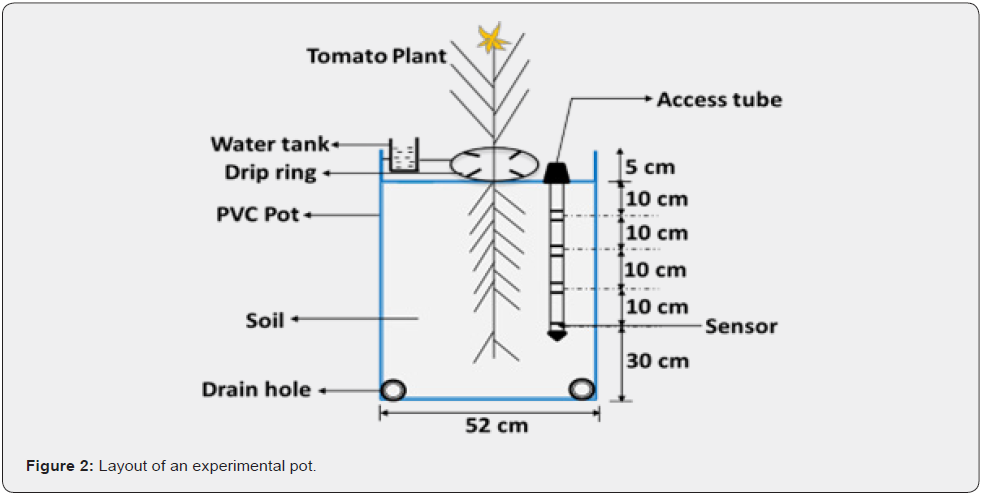


Three primary water sources available in the NAP farms were selected as varying source water qualities including GW, RW (treated in Bolivar Wastewater Treatment Plant (BWTP), South Australia) and mixed water (MW, an equal blend of GW & RW which is one of the popular irrigation sources among NAP farming community). BWTP is operated by All Water International under contract to SA Water which was commissioned in three stages between 1964 and 1969 with design capacity to serve 600,000 people plus industrial waste equivalent to 700,000 people. Sewage comes at the plant through two gravity trunk sewers: one from Gawler- Elizabeth- Salisbury; another from the southern area including a large part of Adelaide and is a huge plant covering about 1500 hectare treatment area. In BWTP, the tertiary treatment is performed at the Dissolved Air Floatation & Filtration (DAFF) plant which makes the turbidity of wastewater about 0.2 NTU; very near to potable water standard and thus treated tertiary effluent is chlorinated and supplied for irrigation to Virginia Irrigation Scheme. Virginia Irrigation Scheme is the first and largest recycled water scheme of its type in Australia and remains one of the largest in the Southern hemisphere which distributes about 15GL per year of highly treated reclaimed water to irrigators in the Virginia, NAP.
The characteristics of water important from irrigation initiative are presented in Supplementary materials-Table S2. The NAP is the largest greenhouse zone of Australia having above 2000 greenhouses and popularly known as the “veggie bowl of South Australia” where the top-most varieties grown are carrots (34,700 tons per year), tomatoes (26,200 tons per year) and potatoes [28]. The tomato is considered as the most important crop in NAP agribusiness because it contributes over 30% of the region’s economic value while occupying less than 4% of its cultivated area [29] (Figure 2).
Design of experiment and irrigation application
A two-factorial randomized design with four replication was applied in this research where water quality and irrigation scenarios represented the first and second factor respectively. There were 12 treatments in the study totaling of 48 experimental pots. A summary of research design with control and test scenarios is provided in the supplementary materials -Table S3.
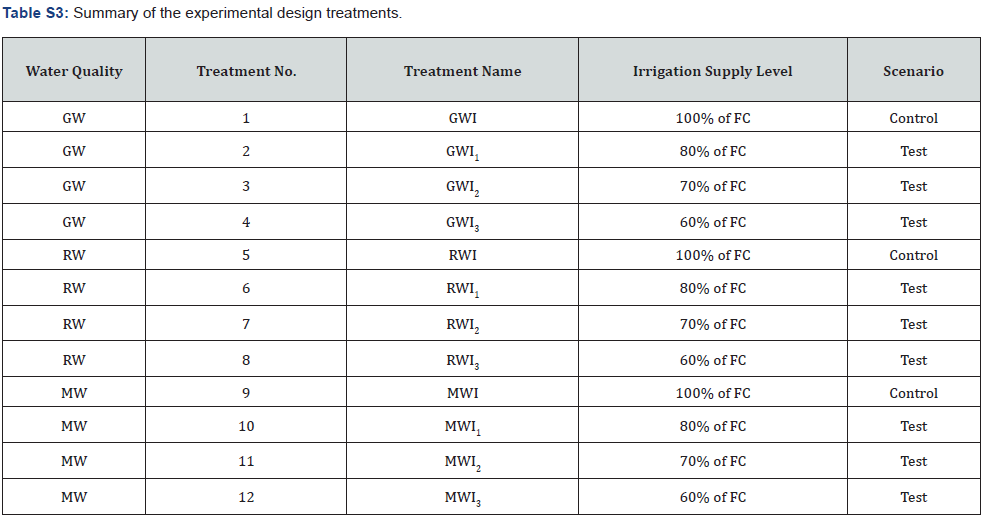
Application of irrigation was based on real time soil moisture data of each treatment. For this, a PR2/4 Profile Probe with access tubes was used following the method employed in [30] and website of manufacturer. Total 36 access tube were installed at 11cm far from center of pot as suggested in [31]. To fulfil the regular irrigation needed for healthy development of tomato crop via drip system, the irrigation frequency was maintained at two days following [32,33]. A detailed stepwise procedure of water quantity calculation and subsequent supply based on full and deficit conditions in each irrigation treatment is explained in [34].
valuation of soil micronutrients
The nutrient analysis of selected micronutrients was carried out at ALS laboratory, Adelaide, South Australia based on the Method 3051H [35] before and after the experiment in each experimental year. The method was compliant with the Australian National Environment Protection Measures, the [36], Schedule (B3).
Measurement of soil pH
Soil pH within the root-zone in each treatment was measured using a low flow porous ceramic cup/ Solusampler and a waterproof pH Meter. The Figure 3 shows how Solu sampler was arranged in actual field. Total 36 Solusampler were used in 12 treatment with three replication each. Soil water contained in porous ceramic cup was extracted using a 60ml syringe following the procedures suggested on [37]. The soil pH in each treatment with three replication was recorded after two hours of sample stabilization in laboratory (Figure 3).
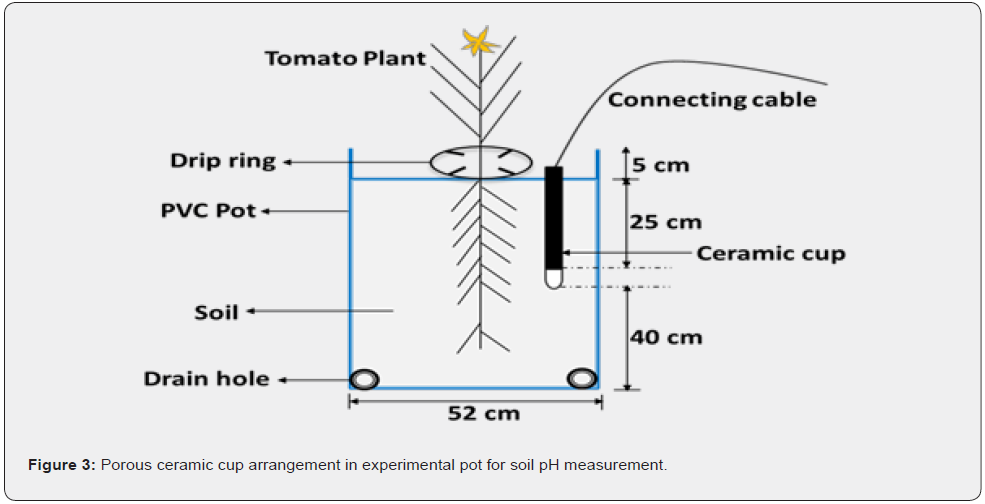
Total carbon sequestration by soil-plant system
In this study, carbon content in plant biomass and field soil after the experiment was assessed to quantify carbon sequestration by the soil and crop system. The carbon content in soil was measured through combustion process at 1350°C, which was evolved as carbon dioxide (CO2) and swept to a measurement cell, quantified by infrared detection. The dried and pulverized sample was combusted in a LECO furnace in the presence of strong oxidants/catalysts. The method employed for calculating total carbon in soil sample was compliant with the NEPM (2013) Schedule (B3). In addition, the carbon content in plant biomass was determined using Elementary Vario Macro C/N analyzer (Elementary Americas, Inc., Mt Laurel, NJ) in Apal Agricultural Laboratory, Magil, South Australia.
Statistical analysis
The data were tabulated, examined and analyzed for each experimental year separately. For analysis, DI levels and water qualities were represented as independent variables whereas soil micronutrients, pH and carbon-sequestration were considered as dependent variables. Three statistical tools including twoway ANOVA, the LSD test at 5% level of confidence and Duncan’s Multiple Range Test were used to analyze the data.
Results and Discussion
Water quality, DI and residual soil micronutrients
Soil micronutrients including Ca, Mg, B, S, Fe, Mn and Zn are important to maintain soil-water-plant relationships of every crop commodities including greenhouse tomatoes because each nutrient plays a different and significant role in overall crop production [38]. However, due to the time and financial limitations, this study is focused on the analysis of the three micronutrients namely Ca, Mg and B. The effects of water quality and different irrigation status on residual soil macronutrients (N, P, K) and rootzone salinity of this study has been published in [27].
Table 1 indicates the summary results of how average residual soil micronutrients varied in selected treatments based on water quality and different irrigation deficiency level in both experimental years. The highest residual Ca was found in soil irrigated with RW. The basic reason may have been due to higher level of Ca concentration in RW than other two sources of water, GW and MW. As presented in Table 4, the findings of this study also indicate that the Ca uptake by and available to plants was highest in full irrigation scenario and going reduced with reduction in water supply level. This resulted in total fruit counts and overall yield reduction in irrigation deficiency conditions as some fruits were affected with blossom-end rot (BER) symptoms in DI treatments, particularly 70% & 60% FC level despite of the water quality which is systematically described in [37]. The result of this study is convergent with [39] who concluded that the marketable yield of tomato fruits might get reduced up to 50% by physiological disorder including BER. According to [40], BER is associated with Ca deficiency in tomato plants which ultimately affects overall production. [41-43] reported that BER is largely related to water availability in root-zone and hence the field conditions where there is severe water deficiency, probability of BER gets higher. Readily available soil-water in root-zone significantly affects the overall crop production both in quantity and quality because limited water supply reduces the nutrients flow essential for photosynthesis and other metabolic processes [38,44,45]. According to [46,47], the nutrient uptake by plants in full irrigation scenario is higher compared to water deficit conditions and the major factor responsible was easy availability of water in prior case.
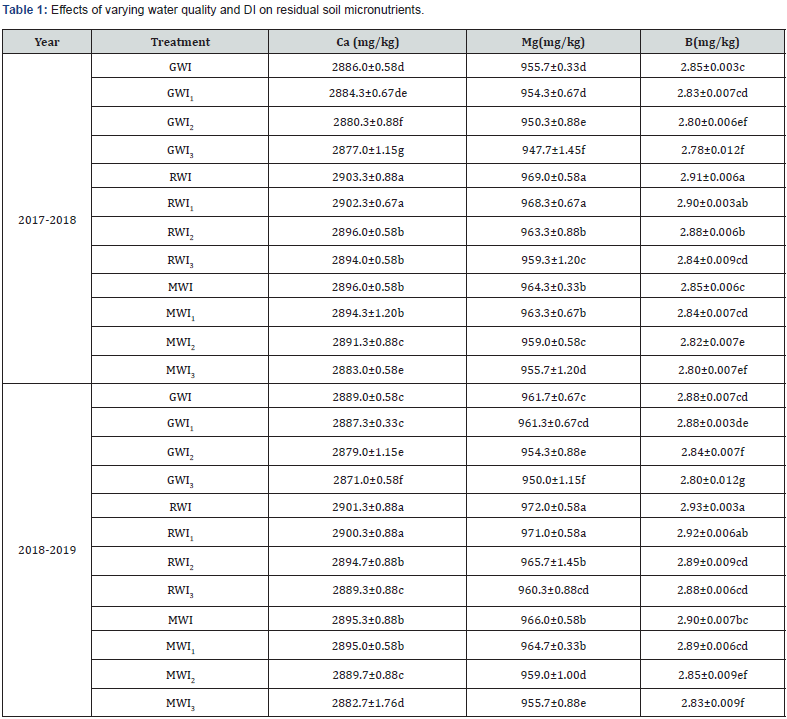
Similar observations were made with Mg and B. In the treatments with RW irrigation, the highest residual B at each water deficit level was recorded because of the higher initial B content in RW. In addition, accumulated Mg and B decreased with the increase in water deficiency provided despite of water quality. This was because, control treatments received more water compared to DI scenarios which resulted in a higher level of micronutrient release to the soil-water and subsequent uptake by the plant. Different abiotic stress conditions including water stress, nutrient stress etc. produce adverse effects in resources use efficiency and hence an optimization of nutrients level in production system is needed to mitigate the stressful effects [48,49]. In their study, [50] examined the influences of irrigation deficiency on nutrient concentration and found that micronutrients including Ca & Mg were significantly affected by drought stress, resulting lower yield.
Table 1 also indicates that the residual Ca concentration in treatments designed SMC at 60% and 70% FC were significantly different to that of the control while treatments at 80% FC were statistically identical to the control despite of water quality. This demonstrated that the Ca accumulation and available to plants in full irrigation and 80% FC level is statistically same which is important from resources use efficiency perspective. Same trend was observed in the cases of residual Mg and B (Table 1). Table 2 indicates a summary of two-way ANOVA resulted from the interaction of water quality and different irrigation level on micronutrients accumulated in soil. As presented in Table 2, it can be seen that all three selected micronutrients, Ca, Mg and B were significantly affected from both independent variables selected: water quality and DI at the chosen significance interval (P < 0.05).
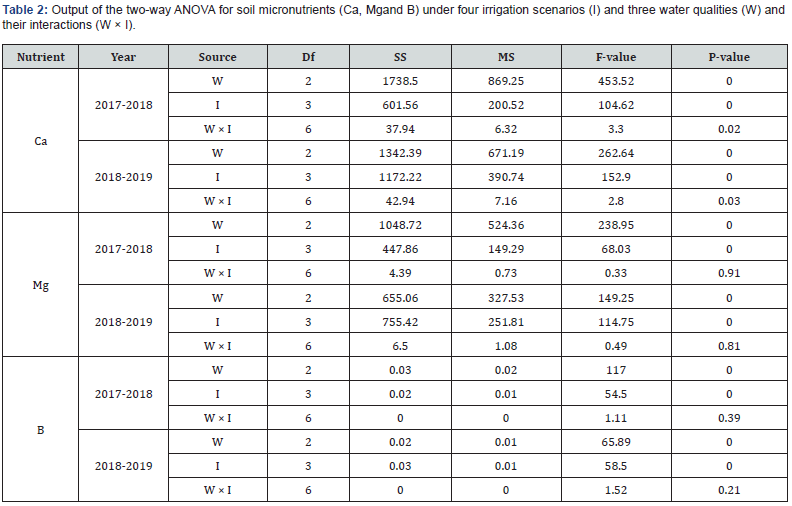
Table 3 summarizes and compares the result (avearge of two experimental years 2017-2018 and 2018-2019) of micronutrient analyses obtained from effects of various irrigation deficiency level and water quality. It is clearly seen that large quantity of micronutrients were supplied via fertigation when RW was chosen as an irrigation source. This not only produced higher nutrients availbility to the plants in RW treatments but also larger residual soil nutrients too. The Table 3 also indicates that there was no significant differences in residual Ca, Mg and B left on soil when SMC was maintained at 80% FC compared to those of the control treatment. This result is important in the optimization of resources use in agriculture because, it in turn, increases nutrient use efficiency in DI scenarios. However, this study recommends an arrangement of leaching facilities to remove salt or excess boron accumulated in plant’s root-zone area particulalry in RW and MW cases so that salinity and nutrients above the recommnded level from irrigation point of view could not affect crop productivity and soil health in long run. In their study of greenhouse-grown tomatoes in South Australian conditions using RW and freshwater, [17] reported that although non-traditional sources of water like RW has strategic importance in demand-side water management, it is essential to check quality parameters regualrly to optimize plant and soil health. In the context of growing demand of water by sectors other than agriculture, the necessity and importance of tapping non-traditional water sources with cost-effective agricultural water management practices is gaining momentum. However, maintaining the healthy environment of soil-plant-water relationship is a key challenge. To fulfil the fertiliser requirements of irrigated agriculture in the context of exponentially increment in chemical fertilizer price globally, betterment in resources use (basically agricultural water and chemical fertilizer) should get top priority. Otherwise, developing countries whose economy relies on agriculture and who imports fertilizers, have to face dark days in food availability very soon. This study suggests that there is no significant differences in residual micronutrients accumulation compared to full irrigation when DI at 80% FC is applied. Thus, the regions where availability of freshwater in famer’s field is expensive, the DI designed at 80% FC could serve as a best strategy to save considerable amount of water and nutrients applied through fertigatio system.
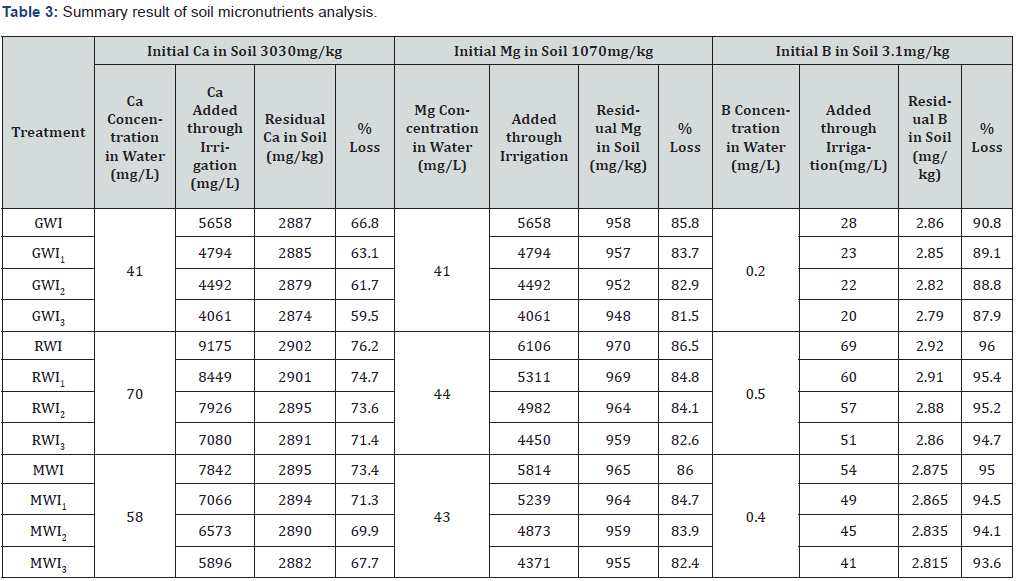
Soil pH distribution in the root-zone
Table 4 summarises the mean value of soil pH in 12 selected treatments at the end of a cropping season. The highest soil pH after the crop growth season was found to be in pots irrigated with RW which is in line with findings of [51]. The highest value of soil pH was 6.94, found in the control treatment RW, followed by RWI1 (6.92) and RWI2 (6.86). Similarly, the lowest pH was measured in highest deficit treatment of GW (6.48,), just lower than GWI2 (6.50) and GWI1 (6.55). The soil pH was found to be decreased with an increasing irrigation deficiency level. After the end of a cropping season, an average of 10.6%, 7.4% and 8.1% reduction in soil pH was observed in control treatments (GWI, RWI and MWI) resepctively. These findings are in agreement with [52], where it was mentioned that DI scenarios with RW as an irrigation source reduced soil pH by 0.4 after a cropping cycle. However, [53] claimed that the RW did not affect the soil pH consistently and it needs continous research to draw a scientific conclusion about the effects of water stress on soil pH. This study found that the soil pH inside the root-zone of all DI treatments were significantly different with each other regardless of water quality. In addition, Table 4 also indicates that the mean soil pH goes on decreasing with increase in water stress level designed.
At higher or lower pH levels, micronutrients become less available to plants. In this study, all 12 treatments after a crop growth season had average pH ranging from 6.5 to 7.0, which indicates that there might not be harmful risk on soil health from pH point of view as the desirable soil pH for greenhouse tomato production is in between 6.0 and 7.5 [40]. However, it arises a question that what will be the ultimate point of irrigation deficiency beyond which the soil pH starts to affect the production system because, after continuous cropping of tomatoes for many seasons with DI application, soil pH value might be lower than the recommended threshold. In such case, soil fertility management measures need to be implemented.
Carbon sequestration by soil-plant system
Initial organic carbon (OC) concentration in the experimental soil was 1.3%. The threshold level of soil OC in effective rootzone area of plants is 1.5% [54]. The residual soil OC remained in different treatment after a cropping cycle is shown in Table 5. Soil irrigated with GW showed the highest soil OC accumulation. This was basically because OC concentration in GW was higher compared to other two sources selected in the study. Of the various DI level, the control treatment, regardless of water quality sequestered significantly higher OC in the soil. The value of soil OC found to be decreased with an increase in degree of irrigation deficiency applied. This happened due to boosted crop biomass in full irrigation compared to water-stressed conditions. According to [55], those crop management practices which improve plant growth result in greater OC storage in soil which is in consistent with the finding of this study. The OC sequestered in soil via treatments in 80% FC was found insignificant to full irrigation at the 5% significance level.
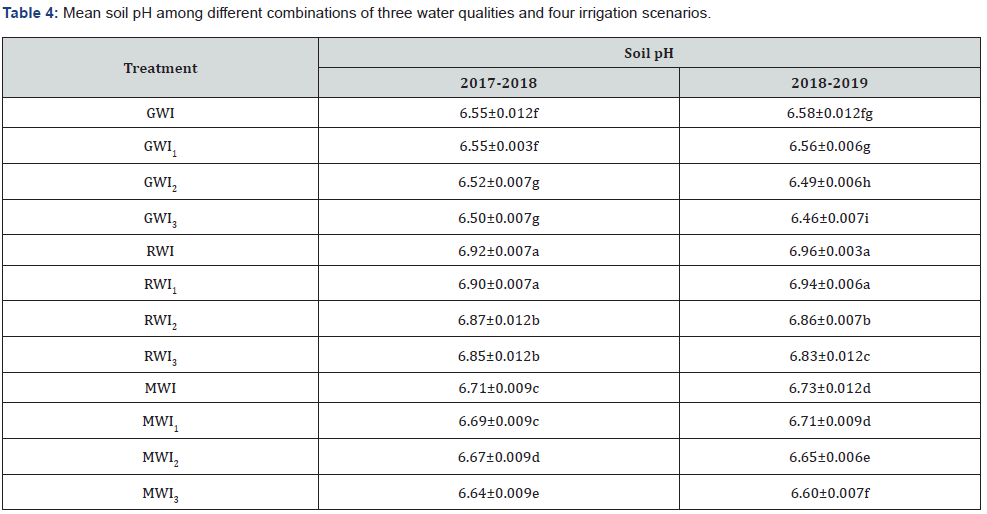
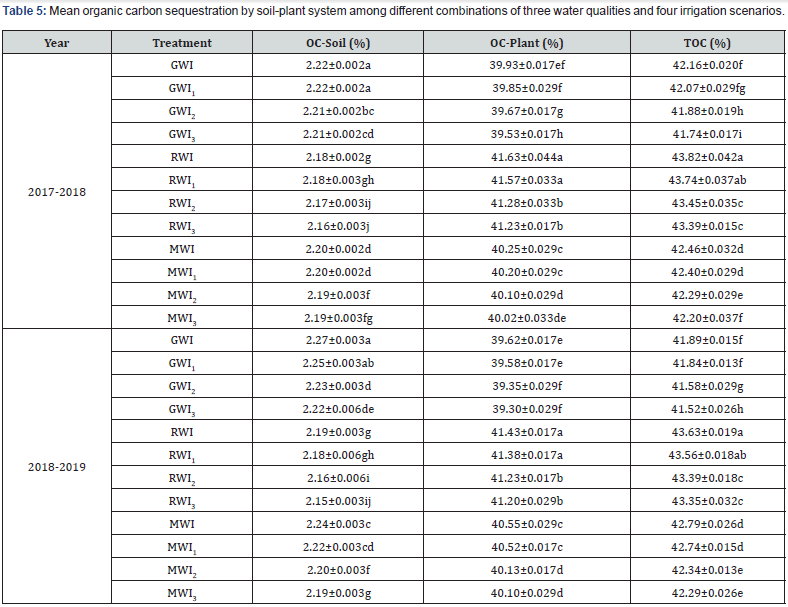
Carbon sequestration basically involves atmospheric CO2 transformation into the soil mass via plant system and includes many advantages like improvement of biodiversity and water quality [54]. They necessitated the importance of adopting best integrated crop water management practices to restore soil health through improving soil OC concentration. It is important to increase OC in soil for decreasing greenhouse gas (CO2) emission and to improve soil health [55]. For example, the yield potential of the crop is severally affected if soil OC is less than 1% [56]. Innovative agronomic practices such as conservation agriculture and integrated crop-water management practices help carbon sequestration in soil [57]. The carbon sequestration in agricultural ecosystem generally depends on climate, microbial activities and management practices like minimum or zero tillage, cover cropping and water management [58]. As soil OC influences soil health and several key pedospheric processes, various ecosystem goods and services significantly depend on it [54].
Table 5 also shows the variation of carbon sequestration by plant system at the end of a cropping season in 12 selected treatments. Of the four DI scenarios, the control treatment despite of water quality resulted in significantly higher OC content in plant than that of the rest. The highest value of plant OC was in RWI, followed by RWI1 and RWI2. The lowest plant OC concentration was found to be in GWI3 (39.4%), which was slightly lower than GWI2 (39.5%) and GWI1 (39.7%). Similar to soil OC, the value of plant OC also followed the trend of decreasing with decrease in water application to crop. This was because plant growth and biomass accumulation was highest in control treatment. Water deficit conditions reduced plant biomass content which eventually decreased plant OC which agrees findings of [55].
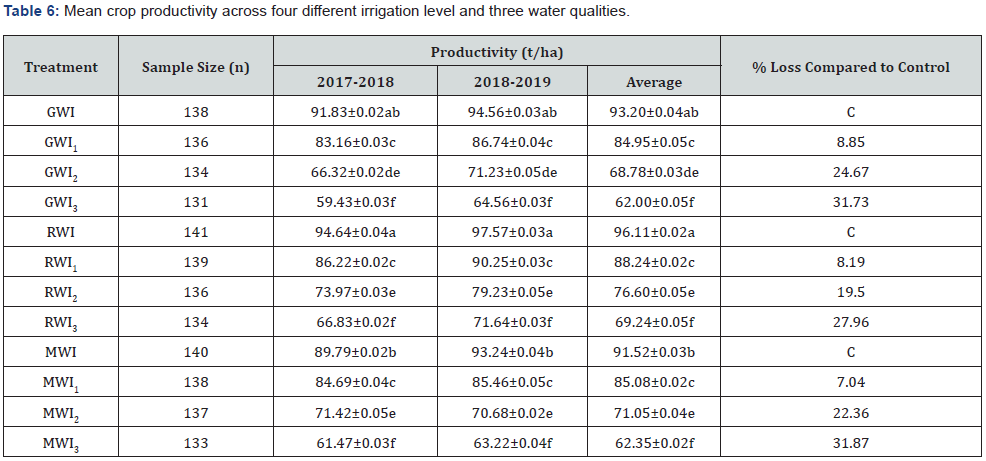
Crop productivity
The effect of different water sources and irrigation level on agricultural productivity of tomatoes cultivated in greenhouse environment was examined in this study which is presented in Table 6. The productivity of selected cultivar was found highest in control treatment as expected despite of water quality. RW demonstrated better performance compared to GW and MW in every level of DI applied. Table 6 indicates that the greenhouse tomatoes productivity value goes on decreasing with increase in water application. The mean values of productivity reduction in 80%, 70% and 60% FC treatment with respect to full irrigation were 8.85, 24.7 and 31.7% respectively in the case of groundwater irrigation. Same trends of productivity loss up to 32% were observed in MW and 28% in RW. Some studies are published dealing productivity reduction due to water stress provided while growing greenhouse tomatoes. For example, a) [59] reported that the productivity of greenhouse tomato cultivar F1 Fantastic was reduced from 111t/ha (full irrigation) to 87t/ha. The percentage loss was 21.6%, b) In their study, [60] found that the crop productivity of variety Mill was 71t/ha in DI while this value was 76 in full irrigation, c) [61] reported the productivity value of cultivar Cochoro in full irrigation condition as 187t/ha while the value dropped to 165 in partial irrigation scenarios, d) [62] studied the effects of water stress on productivity of cultivar Vibelco and found 27.5% productivity loss in DI. The major reason behind productivity reduction in DI condition might be that photosynthesis process gets adversely affected in water stress condition which ultimately hampers crop growth and overall yield [63,64]. However, in the regions where availability of freshwater resources in the farm is limited and expensive for agricultural operations, it might be more practical to improve water productivity compared to just concentrating on yield increments [65].
Conclusion
The major influences of water quality and various DI level on residual micronutrients (Ca, Mg & B), soil pH within the root-zone, carbon sequestration by soil-plant system and crop productivity for tomatoes production were examined. As presented in results and discussions, this study demonstrated that the DI treatment designed at 80% FC and full irrigation were statistically identical for both residual soil micronutrients and carbon sequestration cases. Although the productivity was decreased in DI, it was not in that level detrimental to reduce the production significantly, particularly in the scenarios of 80% FC condition. Therefore, this study recommends that application of DI strategy could be an efficient approach for maintaining soil health and saving resources (basically water and nutrients) in those regions where availability of freshwater is scarce and expensive to farmers. In addition, in the context of exponential rise in chemical fertilizer price throughout the world, the tools and techniques which save resources without compromising yield should be prioritized by government to practice in farmer’s fields. However, due to the large buffer capacity and micronutrients amount, a long-term field or plot experiment is more reasonable compared to pot experiment for investigating the changes of residual micronutrients, pH and carbon in soil under different irrigation status with varying water quality.
Author Contribution
Conceptualization, J.C., G.H., A.H. and B.M.; methodology, J.C., G.H., A.H. and B.M.; data analysis and writing, J.C.; supervision, G.H., A.H. and B.M. All authors have read and agreed to the published version of the manuscript.
Acknowledgment
We would like to acknowledge the Government of Australia for providing Endeavour Postgraduate Scholarship (PhD) to the first author of this research.
References
- Wada Y, van Beek LPH, Bierkens MFP (2012) Non sustainable groundwater sustaining irrigation: A global assessment. Water Res Res 48(6): 1-18.
- Schwartz FW, Ibaraki M (2011) Groundwater: A resource in decline. Elements 7(3): 175-179.
- Aeschbach Hertig W, Gleeson T (2012) Regional strategies for the accelerating global problem of groundwater depletion. Nature Geosci 5: 853-861.
- Stevens DP, Smolenaars S, Kelly J (2008) Irrigation of amenity horticulture with recycled water: A handbook for parks, gardens, lawns, landscapes, playing fields, golf courses and other public open spaces’, Arris Pty Ltd.; Richmond, Victoria, Australia.
- Laurenson S, Kunhikrishnan A, Bolan NS, Naidu R, Mckay J, et al. (2010) Management of recycled water for sustainable production and environmental protection: A case study with Northern Adelaide Plains recycling scheme. Int J Environ Sci Dev 1: 176-180.
- Li B, Cao Y, Guan X, Li Y, Hao Z, Hu W, et al. (2019) Microbial assessments of soil with a 40-year history of reclaimed wastewater irrigation. Sci Total Environ 651(1): 696-705.
- Tran QK, Schwabe KA, Jassby D (2016) Wastewater reuse for agriculture: a development of a regional water reuse decision-support model (RWRM) for cost-effective irrigation sources. Environ Sci Tech 50(17): 9390-9399.
- Petousi I, Daskalakis G, Fountoulakis MS, Lydakis D, Fletcher L, et al. (2019) Effects of treated wastewater irrigation on the establishment of young grapevines. Sci Total Environ 658: 485-492.
- Scherer TF, Franzen D, Cihacek L (2017) Soil, water and plant characteristics important to irrigation. North Dakota State University, North Dakota, USA.
- Rodriguez MH, Schmidt U, Buttner C, Bandte M (2022) Electrolytic disinfection of irrigation water for intensive crop production in greenhouse as demonstrated on tomatoes (Solanum lycopersicum Mill). Horticultuare 8(5): 1-16.
- English M, Raja SN (1996) Perspectives on deficit irrigation. Agric Water Manag 32(1): 1-14.
- Zhang H, Xiong Y, Huang G, Xu X, Huang Q (2017) Effects of water stress on processing tomatoes yield, quality and water use efficiency with plastic mulched drip irrigation in sandy soil of the Hetao Irrigation District. Agric Water Manag 179: 205-214.
- Chand J, Hewa GA, Hassanli A, Myers B (2021) Deficit irrigation on tomato production in a greenhouse environment: A review. J Irrig Drain Eng 147(2): 1-10.
- Garcia Tejero I, Jimenez Bocanegra JA, Martinez G, Romero R, Duran Zuazo VH, et al. (2010) Positive impact of regulated deficit irrigation on yield and fruit quality in a commercial citrus orchard [Citrus sinensis (L.) Osbeck, cv. salustiano]’. Agric Water Manag 97(5): 614-622.
- Patanè C, Tringali S, Sortino O (2011) Effects of deficit irrigation on biomass, yield, water productivity and fruit quality of processing tomato under semi-arid Mediterranean climate conditions. Scientia Horticulturae 129(4): 590-596.
- Alrajhi A, Beecham S, Bolan NS, Hassanli A (2015) Evaluation of soil chemical properties irrigated with recycled wastewater under partial root-zone drying irrigation for sustainable tomato production. Agric Water Manag 161: 127-135.
- Alrajhi A, Beecham S, Hassanli A (2017) Effects of partial root-zone drying irrigation and water quality on soil physical and chemical properties. Agric Water Manag 182: 117-125.
- FAO (2020) Soil salinity management.
- Ribeiro JA, Albuquerque A, Materatski P, Patanita M, Varanda CMR, et al. (2022) Tomato Response to Fusarium spp. Infection under Field Conditions: Study of Potential Genes Involved. Horticultuare 8(5): 433.
- Chan Y, Saidov N, Lee L, Kuo F, Shih S, et al. (2022) Survey of viruses infecting tomato, cucumber and mung bean in Tajikistan. Horticulturae 8(6): 505.
- Nkansah GO, Amoatey C, Zogli MK, Owusu Nketia S, Ofori PA, et al. (2021) Influence of topping and spacing on growth, yield and fruit quality of tomato (Solanum lycopersicum) under greenhouse condition. Front Sus Food Sys 5: 1-12.
- Rivero AG, Keutgen AJ, Pawelzik E (2022) Antioxidant properties of tomato fruit (Lycopersicon esculentum Mill.) as affected by cultivar and processing method. Horticulture 8(547): 1-15.
- Maham SG, Rahimi A, Subramanian S (2020) The environmental impacts of organic greenhouse tomato production based on the nitrogen-fixing plant (Azolla). J Cleaner Prod 245: 118679.
- Liu H, Duan AW, Li FS, Sun JS, Wang YC, et al. (2013) Drip irrigation scheduling for tomato grown in solar greenhouse based on pan evaporation in North China Plain. J Integr Agric 12: 520-531.
- Cui J, Shao G, Lu J, Keabetswe L, Hoogenboom G (2020) Yield, quality and drought sensitivity of tomato to water deficit during different growth stages. Scientia Agricola 77: 1-9.
- Isitekhale H, Osemwota I, Amhakhian S (2013) Poultry manure and NPK fertilizer application and their residual effects on the yield and yield components of tomato ( Mill) in two distinct ecological zones of Central Southern Nigeria. IOSR J Agric Vet Sci (IOSR-JAVS) 3(2): 40-47.
- Chand J, Hewa GA, Hassanli A, Myers B, et al. (2022) Effects of water stress and quality on residual soil macronutrients and root-zone salinity for tomato production in a protected cropping environment. Int J Agric Environ Biores 7: 99-115.
- PIRSA (2019) Northern Adelaide Plains Horticulture Region. Primary Industries and Regions South Australia.
- Kelly J, Stevens D, White T (2017) Achievements of the Virginia Pipeline Scheme: Horticultural production with reclaimed water.
- Savic S, Stikic R, Zaric V, Vucelic Radovic B, Jovanovic Z, et al. (2011) Deficit irrigation technique for reducing water use of tomato under polytunnel conditions. J Cent Eur Agric 12(4): 597-607.
- Soulis KX, Elmaloglou S, Dercasn N (2015) Investigating the effects of soil moisture sensors positioning and accuracy on soil moisture-based drip irrigation scheduling systems. Agric Water Manag 148: 258-268.
- Chen J, Kang S, Du T, Guo P, Qiu R, et al. (2014) Modeling relations of tomato yield and fruit quality with water deficit at different growth stages under greenhouse condition. Agric Water Manag 146: 131-148.
- Wang J, Niu W, Zhang M, Li Y (2017) Effect of alternate partial root-zone drip irrigation on soil bacterial communities and tomato yield. App Soil Ecol 119: 250-259.
- Chand J, Hewa GA, Hassanli A, Myers B (2020) Evaluation of deficit irrigation and water quality on production and water productivity of tomato in greenhouse. Agriculture 10(7): 297.
- USEPA (1997) Test methods for evaluating solid waste physical/chemical methods, USEPA, Washington DC, USA.
- NEPM (2013) National environment protection measure, National Environment Protection Council. Canberra, Australia.
- Hassanli AM, Pezzaniti D (2013) Crop irrigation scheduling in South Australia: a case study. Water 40: 92-97.
- Kiymaz S, Abaci Bayer AA, Beyaz R (2020) The effect of water stress on nutrient elements in soil and leaf of common bean (Phaseolus vulgaris). J Agric Facul Gaziosmanpasa Uni 37(3): 130-140.
- Topcu S, Kirda C, Dasgan Y, Kaman H, Cetin M, et al. (2007) Yield response and N-fertiliser recovery of tomato grown under deficit irrigation. Euro J Agron 26(1): 64-70.
- Haifa (2018) Nutritional recommendations for tomato in open-field, tunnels and greenhouses.
- Diana M, Lazureanu A, Gogosa I, Poiana MA, Harmanescu M, et al. (2007) Influence of NPK fertilization on nutritional quality of tomatoes. Bulletin Agric Sci Vet Med Cluj-Napoca. Faculty of Food processing, Timisoara, Romania.
- Dore J (2008) How to identify and correct tomato nutrient deficiencies?
- Sun Y, Cui X, Liu F (2015) Effect of irrigation regimes and phosphorus rates on water and phosphorus use efficiencies in potato. Scientia Horticulturae 190: 64-69.
- Mahajan S, Tuteja N (2005) Cold, salinity and drought stresses. Arch Biochem Biophy 444(2): 139-158.
- Silva RS, Kumar L, Shabani F, Picanco MC (2017) Assessing the impact of global warming on worldwide open field tomato cultivation through CSIRO-Mk3·0 global climate model. J Agric Sci 155: 407-420.
- Liu C, Rubaek GH, Liu F, Andersen MN (2015) Effect of partial root zone drying and deficit irrigation on nitrogen and phosphorus uptake in potato. Agric Water Manag 159: 66-76.
- Yang H, Du T, Qiu R, Chen J, Wang F, et al. (2017) Improved water use efficiency and fruit quality of greenhouse crops under regulated deficit irrigation in northwest China. Agric Water Manag 179: 193-204.
- Dhaliwal SS, Sharma V, Shukla AK (2022) Chapter One - Impact of micronutrients in mitigation of abiotic stresses in soils and plants- A progressive step toward crop security and nutritional quality. Advan Agron 173: 1-78.
- Akhtar I, Nazir N (2013) Effects of waterlogging and drought stress in plants. Int Water Res Environ Sci 2(2): 34-40.
- Tadayyon A, Nikneshan P, Pessarakli M (2018) Effects of drought stress on concentration of macro- and micro-nutrients in Castor (Ricinus communis ) plant. Journal of Plant Nutrition 41(3): 304-310.
- Amiri SS, Maralian H, Aghabarati A (2008) Heavy metal accumulation in under crown Olea europaea L forest irrigated with wastewater. African J Biotech 7(21): 3912-3916.
- Rattan R, Datta S, Chhonkar P, Suribabu K, Singh A (2005) Long term impact of irrigation with sewage effluents on heavy metal content in soils, crops and groundwater- a case study. Agric Ecosyst Environ 109(3-4): 310-322.
- Mohammad Rusan MJ Hinnawi S, Rousan L (2007) Long term effect of wastewater irrigation of forage crops on soil and plant quality parameters. Desalination 215(1-3): 143-152.
- Lal R, Negassa W, Lorenz K (2015) Carbon sequestration in soil. Current Opi Environ Sustain 15: 79-86.
- Carson J (2019) How much carbon can soil store? University of Western Australia, Perth.
- Kay BD, Angers DA (1999) Soil structure. In: ME Summer (Ed.), Handbook of Soil Science, CRC Press, Boca Raton USA, pp. 229-276.
- Schahczenski J, Hill H (2009) Available online: Agriculture, Climate Change and Carbon Sequestration, ATTRA, USA.
- Abdullahi AC, Siwar C, Shaharudin MI, Anizan I (2018) Carbon sequestration in soils: The opportunities and challenges.
- Kirda CM, Cetin Y, Dasgan S, Topcu H, Kaman B, et al. (2004) Yield response of greenhouse grown tomato to partial root drying and conventional deficit irrigation. Agric Water Manage 69(3): 191-201.
- Jensen CRA, Battilani A, Plauborg F, Psarras G, Chartzoulakis K, et al. (2010) Deficit irrigation based on drought tolerance and root signaling in potatoes and tomatoes. Agric Water Manage 98(3): 403-413.
- Bogale A, Nagle M, Latif S, Aguila M, Müller J (2016) Regulated deficit irrigation and partial root-zone drying irrigation impact bioactive compounds and antioxidant activity in two select tomato cultivars. Sci Hortic 213: 115-124.
- Hakim A, Qinyan Z, Khatoon M, Gullo S (2019) Impact of partial root-zone drying on growth, yield and quality of tomatoes produced in greenhouse condition. Adv Hortic Sci 33(1): 133-138.
- Zheng J, Huang G, Jia D, Wang J, Mota M, et al. (2013) Responses of drip irrigated tomato (Solanum lycopersicum) yield, quality and water productivity to various soil matric potential thresholds in an arid region of Northwest China. Agric Water Manag 129: 181-193.
- Li X, Liu F, Li G, Lin Q, Jensen CR (2010) Soil microbial response, water and nitrogen use by tomato under different irrigation regimes. Agric Water Manag 98(3): 414-418.
- Geerts S, Raes D (2009) Deficit irrigation as an on-farm strategy to maximize crop water productivity in dry areas. Agric Water Manag 96(9): 1275-1284.






























